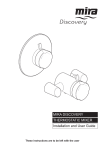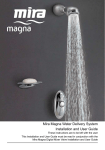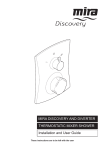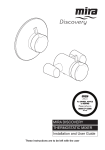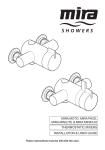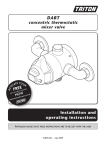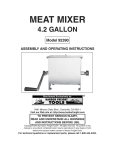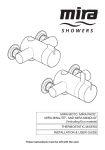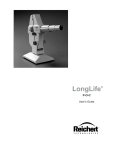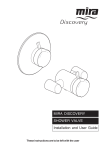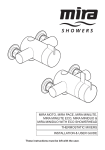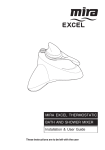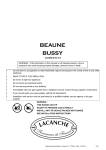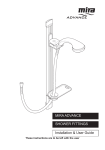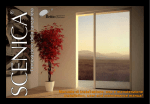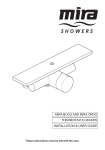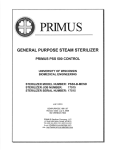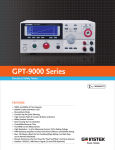Download MIRA SELECT INSTALLATION & USER GUIDE
Transcript
MIRA SELECT THERMOSTATIC MIXER INSTALLATION & USER GUIDE These instructions must be left with the user. 1 the nation’s favourite for PLUMBING & HEATING SUPPLIES FREE SHIPPING SECURE PAYMENTS on all orders over £100 to mainland UK shop online with confidence FINANCE AVAILABLE PRICE MATCH spread the cost with low interest rates always get the best deals available we have H U G E R E D U C T I O N S ON THOUSANDS OF ITEMS Boilers Bathroom suites Radiators Kitchen sinks & taps Heating controls Showers Pipes & ittings Wet rooms Cylinders Towel warmers Fires Bathroom furniture Renewable energy & much more visit our website plumbnation.co.uk CALL US ON 0844 800 3460 INTRODUCTION CONTENTS Introduction Pack Contents 2 3 Safety Warnings 4 Speciications 4 Installation 6 Suitable Plumbing Systems 6 General 6 Installation Methods 7 Exposed Thermostatic Mixer 8 Built-in Thermostatic Mixer 11 RAC Assembly 17 Control Assembly (Built-in Model) 21 Reversed Inlet Supplies 22 Commissioning Maximum Temperature Setting The thermostatic mixer incorporates a wax capsule temperature sensing unit which provides an almost immediate response to changes of temperature of the incoming water supplies to maintain the selected showering temperature. An adjustable temperature stop is provided which limits the maximum temperature to a safe level. Inlet ilters are itted to protect the thermostatic cartridge. 24 24 User Maintenance 25 Fault Diagnosis 25 Lubricants 25 Cleaning 25 In-service Tests 25 Inlet Filters 26 Type 2 Valves 27 Spare Parts 28 Exposed Thermostatic Mixer 28 Built-in Thermostatic Mixer 29 Customer Service The Mira Select thermostatic mixer is a shower control with separate flow and temperature controls. 24 Operation Notes Thank you for purchasing a quality Mira product. To enjoy the full potential of your new product, please take time to read this guide thoroughly. Having done so, keep it handy for future reference. 2 Patents and Design Registration Mira Select Exposed: Thermostatic mixer for connection to rising, falling or rear entry pipework. Mira Select Built-in: Thermostatic mixer for connection to concealed pipework. Includes a right angle connector (RAC) for connecting concealed pipework to exposed shower ittings. This product has been certiied as a Type 2 valve under the BUILDCERT TMV2 scheme. This product also complies with the water supply (water ittings) regulations 1999. 30 Optimum performance of the Mira Select is achieved when used together with Mira Select or Mira Energise Shower Fittings. Back Page Patents and Design Registration Patents: GB: 2 291 693, 2 392 225, 2 421 297 Euro: 1 672 257 DE, FR, GB, IT, NL, SE USA: 7 240 850 Patent Applications: GB: 2 435 077 Euro: 03254070.0 USA: US-2007-0221740-A1 If you experience any difficulty with the installation or operation of your new thermostatic mixer, please refer to ‘Fault Diagnosis’, before contacting Kohler Mira Ltd. Our contact details can be found on the back cover of this guide. Design Registration: 000578463-0004 - 0006 2 Mira Select Built-In PACK CONTENTS Tick the appropriate boxes to familiarise yourself with the part names and to conirm that all of the parts are included. Mira Select Exposed q 1 x Mira Select Shower Control (attached to the Building-in Shroud) q 1 x Control Assembly q 1 x Mira Select Shower Control q 3 x Compression Nuts q 2 x Concealing Plates q 3 x Olives q 2 x Compression Nuts q 1 x 12 L/Min Flow Regulator q 1 x 2.5 mm Hexagon Key q 2 x Olives q 1 x 12 L/Min Flow Regulator q 1 x ‘O’ Key q 1 x 2.5 mm Hexagon Key q 2 x Wall Plugs q 2 x No 8 x 1 ¼” Screws q 1 x ‘O’ Key q 2 x M5 x 40 mm Screws q 2 x Securing Brackets q 2 x No 8 x 1 ¼” Screws q 2 x Bracket Screws q 2 x Wall Plugs OR q 1 x RAC Assembly Documentation q 1 x Guarantee Registration Document q 1 x Installation Template 3 SAFETY WARNINGS SPECIFICATIONS For Type 2 Valves, the supply conditions speciied in section: ‘Type 2 Valves - Application’ take precedence over the operating parameters which follow. Mira thermostatic mixers are precision engineered and should give continued safe and controlled performance, provided: 1. They are installed, commissioned, operated and maintained in accordance with the manufacturer’s recommendations. 2. Periodic attention is given, when necessary, to maintain the product in good functional order. Caution! 1. Read all of these instructions. 2. Retain this guide for later use. 3. Pass on this guide in the event of change of ownership of the installation site. 4. Follow all warnings, cautions and instructions contained in this guide. 5. Anyone who may have dificulty understanding or operating the controls of any shower should be attended whilst showering. Particular consideration should be given to the young, the elderly, the inirm or anyone inexperienced in the correct operation of the controls. 6. Rapid/Excessive movement of the low and/ or temperature control levers may result in momentary unstable blend temperatures. 7. Care is required when adjusting flow or temperature, make sure that the temperature has stabilised. 8. When this product has reached the end of its serviceable life, it should be disposed of in a safe manner, in accordance with current local authority recycling, or waste disposal policy. Pressures Max Static Pressure: 10 Bar. Max Maintained Pressure: 5 Bar. Min Maintained Pressure (Gravity System): 0.1 Bar. (0.1 bar = 1 Metre head from cold tank base to showerhead outlet). Note! For gravity fed or other low pressure systems (0.5 bar or below) do not it the outlet low regulator. For optimum performance supplies should be nominally equal. • • • • Temperatures Factory Pre-set (Blend) Shower: 41°C. Optimum Thermostatic Control Range: 35°C to 43°C (achieved with supplies of 15°C cold, 65°C hot and nominally equal pressures). Recommended Hot Supply: 60°C to 65°C Note! The mixing valve can operate at higher temperatures for short periods without damage, however this could detrimentally affect thermostatic performance. For safety and performance reasons it is recommended that the maximum hot water temperature is limited to 65°C. Cold Water Range: up to 25°C. Minimum Recommended Differential between Hot Supply and Outlet Temperature: 12°C. • • • • • Thermostatic Shut-down For safety and comfort the thermostat will shut off the mixing valve within 2 Seconds if either supply fails (achieved only if the blend temperature has a minimum differential of 12°C from either supply temperature). • Connections Inlets: 15 mm Compression. Outlet: ½” BSP Flat Face / 15 mm Compression Standard connections are: hot - left, cold right, outlet - bottom (Exposed models), top (Built-in models). • • • 4 Dimensions Flow Rates Typical Flow Rates on Low Pressure Systems (0.1 bar to 1 bar) - Mira Select with Mira Fittings: 134 20 Flow Rate (L/Min) Ø71 18 35 16 14 12 10 8 6 Ø56 4 0 0.2 0.4 0.6 0.8 1.0 1.2 1.4 1.6 114 Supply Pressure (Bar) Typical Flow Rates on High Pressure Systems (1 bar to 5 bar, with 12 L/Min Flow Regulator itted in shower control outlet) - Mira Select with Mira Fittings: 149 - 154 13 Flow Rate (L/Min) 12 11 10 9 8 7 6 5 4 30 67 - 85 71 Building-in Depth All dimensions in mm Ø183 5 0 1.0 2.0 3.0 Supply Pressure (Bar) 4.0 5.0 6. Decide on a suitable position for the mixer. The position of the mixer and the shower ittings must provide a minimum gap of 25 mm between the spill-over level of the shower tray/ bath and the showerhead (refer to illustration). This is to prevent back-siphonage. For further information on the installation of your Shower Fittings, refer to the shower ittings installation and user guide. Note! Only use shower ittings recommended by the manufacturer or supplier. INSTALLATION Suitable Plumbing Systems Gravity Fed: The thermostatic mixer must be fed from a cold water cistern (usually itted in the loft space) and a hot water cylinder (usually itted in the airing cupboard) providing nominally equal pressures. Mains Pressurised Instantaneous Hot Water System (Combination Boiler): The thermostatic mixer can be installed with systems of this type with balanced pressures. (Recommended Minimum Maintained Pressure: 1.0 Bar). Hose Retaining Ring Unvented Mains Pressure System: The thermostatic mixer can be installed with an unvented, stored hot water system. Pumped System: The thermostatic mixer can be installed with an inlet pump (twin impeller). The pump must be installed in a suitable location and in accordance with its instructions. 25 mm Spill Over Level General Installation must be carried out in accordance with these instructions, and must be conducted by designated, qualiied and competent personnel. The installation must comply with the “Water Supply Regulations 1999 (Water Fittings)” or any particular regulations and practices, speciied by the local water company or water undertakers. Note! Make sure that all site requirements correspond to the information given in section: ‘Speciications’. For Type 2 Valves see also supply conditions in section: ‘Type 2 Valves’. 1. The mixer must not be installed in an area where it may freeze. 2. For stud partitions alternative ixings may be required. 3. Isolating valves must be installed close to the Mixer for ease of maintenance. 4. Pipework must be rigidly supported and avoid any strain on the connections. 5. Pipework dead-legs should be kept to a minimum. 6 For installation into a solid wall or stud partition using the securing brackets, refer to section: ‘Built-in Thermostatic Mixer, 1. Solid Wall or Stud Partition (Using Securing Brackets Mounting on Front Face of Wall)’. Installation Methods The Exposed Select Thermostatic Mixer can be installed with rear, rising or falling supply inlets. Note! The thermostatic mixer has adjustable inlets to it existing pipework centres between 149 mm and 154 mm. For rear entry supplies, refer to section: ‘Exposed Thermostatic Mixer, 1. Rear Entry Supplies’. Securing Brackets (mounting on front surface of wall) For installation into a solid wall or stud partition using the rear fixing points, refer to section: ‘Built-in Thermostatic Mixer, 2. Solid Wall or Stud Partition (Using Rear Fixing Points on Thermostatic Mixer)’. For rising or falling supplies, refer to section: ‘Exposed Thermostatic Mixer, 2. Rising or Falling Supplies’. Mounting using rear ixing points For installation behind a laminated panel using the securing brackets, refer to section: ‘Built-in Thermostatic Mixer, 3. Laminated Panel (Using Securing Brackets - Mounting on Rear Face of Wall)’. The Built-in Select Thermostatic Mixer can be installed with rising or falling supply inlets (rising inlets are illustrated). The thermostatic mixer can be installed using the rear ixing points, or by using the securing brackets (supplied) on the front surface of a solid wall or stud partition, or on the rear surface of a laminated panel. Securing Brackets (mounting on rear surface of wall) 7 Ø32 mm x 10 mm depth for Concealing Plates Exposed Thermostatic Mixer 1. Rear Entry Supplies (rising or falling concealed pipework) Backplate Cold 13 mm from inished wall surface 1. Use the installation template to mark the positions of the holes for the backplate and the pipe centres. Note! Allow a minimum of 150 mm either side of the mixing valve, to allow access to the hot and cold inlet ilters for servicing. Hot 153 mm Apply Silicone Sealant Concealing Plates 13 mm Ø 32 mm 150 mm 150 mm 153 mm 40 mm Shower Control Backplate Fixing Points (Ø6 mm) Hot Supply Inlet (Ø15 mm) Cold Supply Inlet Make sure that supply pipes are thoroughly flushed through before connection to the shower control Bend tabs inwards Use as a support for the spirit level Bend tabs inwards Use as a support for the spirit level Elbow 153 mm 10 mm minimum between elbow and inished wall surface 6. Loosen the grubscrew with the 2.5 mm hexagon key (supplied) and remove the backplate from the mixing valve. 7. Secure the backplate to the wall using the screws (supplied). 8. Fit the concealing plates. Note! Apply silicone sealant to the back face of the lange. Caution! It is essential at this point that the supply pipework is thoroughly lushed through before connection to the mixing valve. Failure to do so may result in product malfunction. 9. Fit the compression nuts and olives onto the pipework. 10.Align the mixing valve with the pipework and it onto the backplate. Minor misalignment of the pipework can be accommodated by the inlets, which are adjustable between 149 and 154 mm centres. 11. Tighten the compression nuts onto the elbows with a suitable spanner. Caution! Take care not to damage the chrome surfaces. (Ø15 mm) 40 mm 2. For solid walls drill the holes for the backplate with a Ø6 mm drill and insert the wall plugs (supplied). For other types of wall structure alternative fixings may be required (not supplied). 3. Drill the holes for the supply pipes at 153 mm centres. 4. Create a recess in the wall to allow for the concealing plates, Ø32 mm x 10 mm deep. Note! Depth must be suficient to prevent the concealing plates fouling on the plumbing elbows. 5. Fit the supply pipework (Hot - Left, Cold Right). The pipework must project 13 mm from the inished wall surface at 153 mm centres (use the Installation Template as a guide). Note! If the connections are reversed, complete the installation then refer to section: ‘Reversed Inlet Supplies’. 8 Cold 2. Rising or Falling Supplies 1. Loosen the grubscrew on each elbow using the 2.5 mm hexagon key (supplied) and rotate the elbow 90° as required. Retighten the grubscrews. Note! Do not overtighten. Hot Grubscrew Flow Regulator 12.Tighten the grubscrew to secure the mixing valve to the backplate. 13.Fit the shower ittings, refer to your shower fittings installation and user guide for instructions. Note! For high pressure systems, a 12 L/Min low regulator (supplied) can be itted under the hose washer (refer to illustration). Important! The itting of this low regulator will invalidate any TMV2 compliance due to the minimum low rate requirements, do not it the low regulator in these applications. 14.Turn on the hot and cold water supplies and check for leaks. 15.Before using the shower, refer to section: ‘Commissioning’. 2. Use the installation template to mark the positions of the fixing holes for the backplate. Note! Allow a minimum of 150 mm either side of the mixing valve to allow servicing of the hot and cold inlet ilters. 150 mm 153 mm 153 mm 40 mm Shower Control Backplate Fixing Points (Ø6 mm) Hot Supply Inlet (Ø15 mm) Cold Supply Inlet Make sure that supply pipes are thoroughly flushed through before connection to the shower control Bend tabs inwards Use as a support for the spirit level Bend tabs inwards Use as a support for the spirit level 150 mm (Ø15 mm) 40 mm 3. For solid walls, drill the holes for the backplate with a Ø6 mm drill and insert the wall plugs (supplied). For other types of wall structure, alternative fixings may be required (not supplied). 9 4. Using the installation template as a guide, set the pipe centres 35 mm from the inished wall and mark the pipe positions. 5. Fit the supply pipework (Hot - Left, Cold Right). Note! If the connections are reversed, complete the installation then refer to section: ‘Reversed Inlet Supplies’. 11. Tighten the grubscrew to secure the mixing valve to the backplate. 35 mm 12.Fit the shower ittings, refer to your shower ittings installation and user guide. Note! For high pressure systems, a 12 L/Min low regulator (supplied) can be itted under the hose washer (refer to illustration). Important! The itting of this low regulator will invalidate any TMV2 compliance due to the minimum low rate requirements, do not it the low regulator in these applications. 153 mm Wall Plugs 6. Loosen the grubscrew with the 2.5 mm hexagon key (supplied) and remove the backplate from the mixer. 7. Secure the backplate to the wall using the screws (supplied). Caution! It is essential at this point that the supply pipework is thoroughly lushed through before connection to the mixing valve. Failure to do so may result in product malfunction. 8. Fit the compression nuts and olives onto the pipework. 9. Align the mixing valve with the pipework and it onto the backplate. Minor misalignment of the pipework can be accommodated by the inlets, which are adjustable between 149 and 154 mm centres. 10.Tighten the compression nuts onto the mixer with a suitable spanner. Caution! Take care not to damage the chrome surfaces. Flow Regulator 13.Turn on the hot and cold water supplies and check for leaks. 14.Before using the shower, refer to section: ‘Commissioning’. 10 Alternative Pipe Layouts Built-in Thermostatic Mixer 1. Solid Wall or Stud Partition (Using Securing Brackets Mounting off Front Face of Wall) Outlet Pipe BIV 1. Determine the route for the hot and cold supply pipework and for the outlet pipework. When connecting to the BIV shower ittings it is recommended that the outlet be positioned above and to one side of the mixing valve. This is to prevent the lexible hose from obstructing the shower controls. 2. Remove the two shroud screws (retain for later use) and separate the mixing valve from the building-in shroud. 3. Determine the position of the mixing valve and draw around the building-in shroud. Outlet Pipe BIR Outlet Pipe BIV Thermostatic Mixer Hot Inlet Cold Inlet 6. Remove the plasterboard and/or brick work to a minimum depth of 62 mm. 6 mm Min. Finished Wall Shroud Screws (retain for later use) Finished Wall Surface 4. Mark the routes for the hot and cold supply pipework at 108 mm centres (Hot - Left, Cold - Right). Falling supplies: For falling supplies loosen the grubscrew on each elbow using the 2.5 mm hexagon key (supplied). Remove the elbows and install on opposite sides. Retighten the grubscrews. Note! Do not overtighten. Note! Make sure that the ‘O’ seals are correctly itted and that the ilter plugs are positioned to the front (i.e. hexagonal key hole facing forward). 5. Mark the route for the outlet pipework. Note! The outlet elbow should be sited above the mixing valve and on the right or left, as site dictates. Securing Bracket 62 mm Min. 11 24 mm Max. Finished Wall 12.Connect the outlet pipework and install the RAC assembly or BIR assembly, before continuing with the installation of the mixing valve. RAC assembly, go to section: ‘Installation, RAC Assembly’. BIR assembly - refer to your shower ittings installation and user guide and follow instructions 13 to 19. 7. Secure the securing brackets to the mixing valve with the bracket screws. Important! Make sure that the correct holes are used, otherwise the backplate cannot be itted. Note! The securing brackets can be rotated for suitable ixing points. Countersunk Fixing Hole Rotate for Suitable Fixing Point Outlet Pipe to Fittings Rear Fixing Point Screws Backplate securing hole Cold Hot Note! Securing Brackets shown in preferred position to allow the Compression Nuts to be tightened. 13.Secure the building-in shroud to the mixing valve using the two shroud screws removed earlier. 14.Using the building-in shroud as a guide, inish the wall, e.g. tiles. Caution! Make sure that the inished wall is within the maximum and minimum limits and to an even depth (no greater than 2 mm variation) or the control components will not it correctly. 8. Making sure that the mixing valve is level, mark the positions for the countersunk ixing holes on the wall. 9. For solid walls, drill two Ø6 mm holes for the wall plugs. Caution! Do not drill into pipes or electrical cables buried in the wall. 10.Fit the wall plugs provided and secure the mixing valve to the wall with the screws supplied. Note! For stud partition installations, alternative ixings may be required (not supplied). 11. Connect the hot and cold supply pipes and tighten the compression nuts. Caution! Make sure that the olives are itted and all pipework is lushed through before connecting to the mixing valve. 12 Minimum Finished Wall Surface Finished Wall F9802 Min Max Maximum Finished Wall Surface 15.Remove the two shroud screws (retain for later use) and remove the building-in shroud. 16.Fit the concealing plate and control assembly. Refer to section: ‘Control Assembly’. 13 2. Solid Wall or Stud Partition (Using Rear Fixing Points on the Thermostatic Mixer) 3. Make sure that the mixing valve is level, central in the hole and square to the inished wall surface. This is to make sure that the control assembly will it correctly. Mark the positions of the ixing screw holes on the wall. 4. For solid walls, drill two Ø6 mm holes for the wall plugs. 5. Insert the wall plugs (supplied) and secure the mixing valve to the wall with the screws provided. Note! For stud partition installations alternative ixings may be required (not supplied) to ix the mixing valve to the rear face of the wall cavity or to a timber noggin. 1. Refer to section: ‘1. Solid Wall or Stud Partition (Using Securing Brackets Mounting off Front Face of Wall)’ and follow steps 1 to 4. 2. Cut away the plasterboard and/or brick work to the required depth. Important! This depth ‘X’ will depend on the inished wall thickness e.g. tiles or facia board. Refer to the table for this measurement. For stud partitions depth ‘X’ refers to the distance from the rear mounting e.g. timber noggin, to the front of the wall (before tiling). Outlet Pipe to Fittings Finished Wall Surface Screws Rear Fixing Cold Hot Finished Wall Thickness 6. Refer to section: ‘1. Solid Wall or Stud Partition (Using Securing Brackets Mounting off Front Face of Wall)’ and follow steps 11 and 12. Depth ‘X’ Finished Wall Thickness (e.g. tile and adhesive) Wall Cutout Depth ‘X’ 4 mm 81 - 63 mm 6 mm 79 - 61 mm 8 mm 77 - 59 mm 10 mm 75 - 57 mm 12 mm 73 - 55 mm 14 mm 71 - 55 mm 16 mm 69 - 55 mm 18 mm 67 - 55 mm 20 mm 65 - 55 mm 22 mm 63 - 55 mm 24 mm 61 - 55 mm 14 3. Laminated Panel (Using Securing Brackets Mounting on Rear Face of Wall) Backplate Securing Hole M5 Fixing Hole Filter Plug Note! For laminated panels the mixing valve must be positioned from the rear of the panel. Panel thickness must be between 4 and 12 mm. (If a thicker panel is used, it will be necessary to recess the securing brackets into the rear of the panel.) Important! Make sure that there is a minimum clearance of 64 mm behind the laminated panel to accommodate the mixing valve. 1. Remove the two shroud screws (retain for later use) and separate the mixing valve from the building-in shroud. Backplate Securing Hole M5 Fixing Hole 5. Position the mixing valve on the front of the panel, make sure that it is level and central in the hole, then mark the position of the M5 ixing holes. Important! Make sure that the correct holes are used (refer to illustration). Note! Make sure that the filter plugs are positioned so that they can be removed for servicing. 6. Drill the two Ø5.5 mm holes for the ixing positions (countersink the holes at the front). 7. Secure the mixing valve on the rear of the panel with the M5 x 40 mm screws as shown. Shroud Screws (retain for later use) 2. Mark the position of the mixing valve using the building-in shroud as a guide. 3. Carefully cut out the laminated panel. 4. Secure the securing brackets to the mixing valve with the bracket screws. Important! The securing brackets must be ixed vertically, as illustrated. Important! Make sure that the correct holes are used, otherwise the backplate cannot be itted. M5 x 40 mm Fixing Screws 15 8. Fit the hot and cold supply pipes (hot - left, cold - right) and tighten the compression nuts. Caution! Make sure that the olives are itted and all pipework is lushed through before connecting to the mixing valve. Outlet Pipe to Fittings Cold Hot 9. Connect the outlet pipework and install the RAC assembly or BIR assembly, before continuing with the installation of the mixing valve. RAC assembly, go to section: ‘Installation, RAC Assembly’. BIR assembly - refer to your shower ittings installation and user guide. 10.Fit the concealing plate and control assembly. Refer to section: ‘Control Assembly’. 16 RAC Assembly 2. Temporarily cap off the outlet pipe, turn on the water supplies and check for leaks. 3. Determine the inished wall position (e.g. tile thickness). Turn off the water supply, carefully uncap the outlet pipe and cut to length, the outlet pipe must protrude through the inished wall surface by 21–23 mm. Note! Remove any burrs from the pipes before proceeding. 4. For solid wall installations or stud partition installations without rear access go to instruction 11. For stud partition installations with access to the rear of the partition continue with instruction 5. 5. Secure the building-in shroud to the mixing valve using the two building-in shroud screws removed earlier. 6. Using the building-in shroud as a guide, inish the wall, e.g. tiles. Caution! Make sure that the inished wall is within the maximum and minimum limits and to an even depth (no greater than 2 mm variation) or the control components will not it correctly. There are two types of RAC assembly available depending on the shower ittings supplied with your product. Identify your RAC assembly and follow the appropriate installation instructions. Mira Energise RAC Mira Select RAC Mira Energise RAC: 1. Before the RAC assembly can be itted you must have irst installed your built-in shower control and have connected the inlet and outlet pipework. Important! Make sure that the outlet pipework protrudes through a Ø25 mm hole in the wall or stud partition by approximately 40 mm. Note! For stud partition installations where access to the rear of the partition is possible, it the RAC wallplate over the outlet pipework on the inside of the partition. For stud partition installations where access to the rear of the wall is not possible, follow instructions for solid wall installations, making sure that suitable wall ixings (not supplied) are used to secure the wallplate to the outside of the stud partition. Minimum Finished Wall Surface Finished Wall F9802 Min Max Maximum Finished Wall Surface RAC Wallplate (shown itted for rear access stud partitions only) 40 mm Outlet Pipe to Fittings 7. Remove the two building-in shroud screws (retain for later use) and remove the building-in shroud. 8. Place the RAC backplate over the outlet pipe with the arrow pointing up. The screw holes should be at 45° to the horizontal. 17 15.For solid walls drill two Ø6 mm holes for the wall plugs. For other types of wall structure alternative fixings may be required (not supplied). If necessary, make a recess 6 mm deep to accept the wallplate for lush itting of the outlet to the wall surface. Caution! Make sure that you do not drill into pipework in the wall. 16.Fit the two wall plugs supplied and secure the wallplate to the wall with the two wallplate screws. 17.Make sure that there is clearance behind the wallplate and temporarily it the two backplate screws into the wallplate. This will prevent the ixing holes from becoming blocked with plaster or grout. 18.Secure the building-in shroud to the mixing valve using the two shroud screws removed earlier. 19.Using the building-in shroud as a guide, inish the wall, e.g. tiles. Caution! Make sure that the inished wall is within the maximum and minimum limits and to an even depth (no greater than 2 mm variation) or the control components will not it correctly. 9. Mark the positions of the two RAC backplate ixing holes and drill two Ø5.5 mm holes. Caution! Make sure that you do not drill into pipework in the wall. 10.Hold the RAC wallplate in position on the rear of the partition, insert the two backplate screws and secure the RAC backplate to the wallplate. Make sure that the foam seal abuts the inished wall surface. Go to instruction 22. RAC Backplate Backplate Screws 11. Loosely attach the RAC backplate to the RAC wallplate, using the two backplate screws provided. 12.Place the RAC backplate/wallplate assembly over the outlet pipe with the arrow pointing vertically up. The screw holes should be at 40° to the horizontal. 13.Mark the positions of the two RAC wallplate ixing holes. Minimum Finished Wall Surface Finished Wall F9802 Min Max Wallplate Maximum Finished Wall Surface Arrow 40° RAC Backplate Backplate Screws 20.Remove the two backplate screws, the two building-in shroud screws (retain for later use) and the building-in shroud. 21.Place the backplate over the outlet pipe with the arrow pointing vertically up and tighten the two backplate screws. Make sure that the foam seal abuts the inished wall surface. 14.Remove the assembly from the wall and separate the backplate from the wallplate. 18 Mira Select RAC: 1. Before the RAC assembly can be itted you must have irst installed your built-in shower control and have connected the inlet and outlet pipework. Important! Make sure that the outlet pipework is securely ixed and that you leave enough pipe to connect a 1/2" BSP female itting (not supplied) to the RAC assembly. 2. Apply liquid sealant or PTFE tape (do not use paste) to the brass nipple and screw into the 1/2" BSP female itting (not supplied). Important! For stud partition installations screw a backnut (not supplied) on the rear of the brass nipple. RAC Backplate Backplate Screws 22.Check that the blue ‘O’ seal is itted inside the backplate nut. Fit the olive and the backplate nut over the outlet pipe and tighten the nut. 23.Check that the second ‘O’ seal (black) is itted to the outside of the backplate nut. Press the elbow onto the backplate, make sure that the clips on the elbow engage with the backplate. 24.Press the shroud over the elbow, make sure that it engages with the lugs on the backplate. Finished Wall Surface Backnut (not supplied) 20 - 22 mm 20 - 22 mm Olive Backplate Nut 1/2" BSP Female Fitting (not supplied) Elbow Solid or Dry Lined Walls Laminated Panel or Stud Partition Walls 3. Temporarily cap off the brass nipple, turn on the water supplies and check for leaks. 4. Determine the inished wall position (e.g. tile thickness). Turn off the water supply, carefully uncap the brass nipple and, if necessary, cut to length, the brass nipple must protrude through the inishedwallsurface by 20–22 mm. 5. Secure the building-in shroud to the mixing valve using the two building-in shroud screws removed earlier. 6. Using the building-in shroud as a guide, inish the wall, e.g. tiles. Caution! Make sure that the inished wall is within the maximum and minimum limits and to an even depth (no greater than 2 mm variation) or the control components will not it correctly. Shroud 25.This completes the installation of the RAC assembly, fit the concealing plate and control assembly. Refer to section: ‘Control Assembly’. 19 9. Push the elbow fully into the backplate and rotate it clockwise, a ‘click’ will indicate when it is locked. To unlock, insert a small flat blade screwdriver into the release slot on the underside, then turn the elbow anticlockwise until it is released from the backplate. Minimum Finished Wall Surface Finished Wall F9802 Min Max Backplate Maximum Finished Wall Surface Elbow To Lock 7. Remove the two building-in shroud screws (retain for later use) and remove the building-in shroud. 8. Apply liquid sealant or PTFE tape to the exposed end of the brass nipple. Screw the mounting bush on until the backplate is loosely clamped against the wall. Then rotate the backplate and position as shown to align the arrow and release slot. Tighten the mounting bush with a 24 mm A/F spanner. Release Slot To Unlock 10.Locate the shroud over the elbow, then carefully push until it ‘clicks’ into place securely. Brass Nipple Foam Seal Elbow Backplate Shroud Mounting Bush 11. This completes the installation of the RAC assembly, fit the concealing plate and control assembly. Refer to section: ‘Control Assembly’. Backplate Release Slot 20 5. Locate the low control lever over the control assembly and push irmly into place. 6. Fit the bearing onto the low lever. Note! Align the bearing with the cutouts on the control assembly. Control Assembly (Built-in Model) 1. Unscrew the grubscrew and pull off the temperature control knob, bearing and low control lever. 2. Carefully separate the control assembly. Note! Use a screwdriver in the cutout to assist separation of the concealing plate from the backplate. Flow Control Lever Backplate Concealing Plate Bearing Flow Control Lever 7. Fit the shower ittings, refer to your shower ittings installation and user guide. Note! For high pressure systems, a 12 L/Min low regulator (supplied) can be itted under the hose washer. Important! The itting of this low regulator will invalidate any TMV2 compliance due to the minimum low rate requirements, do not it the low regulator in these applications. Cutout Bearing Temperature Control Knob Hose Washer 3. Attach the backplate using the two shroud screws removed previously. Tighten the screws until the foam seal is compressed against the inished wall. Do not overtighten. 4. With the cutout at the bottom, locate the concealing plate over the mixer, engage the crosses in the concealing plate with the square recesses in the backplate, and push irmly until the concealing plate clicks into position. Flow Regulator 8. Turn on the hot and cold water supplies and check for leaks. 9. Before using the shower, refer to section: ‘Commissioning’. 21 Reversed Inlet Supplies Thermostatic Cartridge The Mira Select thermostatic mixer is supplied with inlet connections Hot - Left, Cold - Right and Outlet - Bottom (exposed models), Outlet - Top (built-in models) as standard. If the hot and cold water supply pipes have been reversed during installation, the thermostatic cartridge must be removed and rotated 180°. ‘O’ Key Flow Lever Adaptor Control Interface Exposed Model: 1. Isolate the hot and cold water supplies and operate the flow control lever to relieve pressure and drain any residual water. 2. Loosen the temperature control knob grubscrew with a 2.5 mm hexagonal key and pull off the temperature control knob, low control lever and bearing. 5. Rotate the thermostatic cartridge 180°. 6. Make sure that the two inlet seals are itted and carefully push the thermostatic cartridge back into the mixing valve, aligning the lugs into the slots. Note! Check that the cartridge lug stamped ‘H’ is aligned with the hot inlet supply. Important! Take care when fitting the thermostatic cartridge. Damage to the cartridge inlet seals may result in dripping from the showerhead. 7. Tighten the nut by turning the ‘O’ key clockwise. 8. Refit the controls in reverse order. Make sure the shower operates correctly. Refer to section: ‘Commissioning’. Bearing Flow Control Lever Temperature Control Knob 3. Rotate the white section of the control interface clockwise by 90° and pull off the control interface and low control lever adaptor. 4. Locate the ‘O’ key (supplied) onto the cartridge nut and turn anticlockwise. Unscrew fully and pull the thermostatic cartridge from the mixing valve. 22 7. Rotate the thermostatic cartridge 180°. 8. Make sure that the two inlet seals are itted and carefully push the thermostatic cartridge back into the mixing valve, aligning the lugs into the slots. Note! Check that the cartridge lug stamped ‘H’ is aligned with the hot inlet supply. Important! Take care when fitting the thermostatic cartridge. Damage to the cartridge inlet seals may result in dripping from the showerhead. 9. Tighten the nut by turning the ‘O’ key clockwise. 10.Reit the controls in reverse order. Note! When reitting the bearing, make sure that the cutouts are aligned with the control assembly. 11. Make sure the shower operates correctly. Refer to section: ‘Commissioning’. Built-in Model: 1. Isolate the hot and cold water supplies and operate the flow control lever to relieve pressure and drain any residual water. 2. Loosen the temperature control knob grubscrew with a 2.5 mm hexagonal key and pull off the temperature control knob, bearing and low control lever. 3. Carefully unclip the concealing plate from the backplate. Note! Use a suitable screwdriver in the cutout to assist separation. Backplate Concealing Plate Flow Control Lever Cutout Bearing Temperature Control Knob 4. Unscrew the two backplate screws and remove the backplate. 5. Pull off the red low lever adaptor. 6. Locate the ‘O’ Key (supplied) onto the cartridge nut and turn anticlockwise. Unscrew fully and pull the thermostatic cartridge from the mixing valve. Thermostatic Cartridge ‘O’ Key Flow Lever Adaptor Backplate 23 6. Refit and secure the temperature control knob. 7. Check that the showering temperature is correct. If the correct temperature setting cannot be achieved, refer to section: ‘Fault Diagnosis’. COMMISSIONING Maximum Temperature Setting Before using the shower the maximum temperature must be checked to make sure that it is at a safe level. It has been preset to approximately 41°C at the factory but due to variations in site conditions the maximum temperature may need adjustment. Note! Make sure that the hot water temperature is at least 55°C and that there is suficient supply. For Type 2 installations the maximum blend temperature is determined by the application, refer to section: ‘Type 2 Valves - Application’. 1. Turn on the mixer to the maximum temperature and maximum low (i.e. fully anticlockwise) and allow the temperature to stabilise. If the temperature is too hot or too cold adjust as follows: 2. Loosen the temperature control knob grubscrew with the 2.5 mm hexagon key (supplied) and pull off the temperature control knob. 3. Insert the 2.5 mm hexagon key into the centre of the green hub and engage with the hidden temperature adjusting screw. 4. Turn the hexagon key until the required maximum showering temperature is obtained. Turn anticlockwise to increase or clockwise to decrease the temperature (¼ turn = approximately 1°C). OPERATION Turn the Flow Control Lever anticlockwise to the preset maximum low OFF + - + ON Turn the Temperature Control Knob clockwise to decrease the temperature and anticlockwise to the preset maximum temperature 5. Once the desired maximum blend temperature has been achieved, turn off the shower. 24 Lubricants USER MAINTENANCE Silicone based lubricants must only be used on the rubber seals. Caution! Oil based or other lubricant types may cause rapid deterioration of seals. If you require a Mira trained service engineer or agent, refer to section: ‘Customer Services’. Fault Diagnosis Cleaning Symptom: Only hot or cold water from the mixer outlet. Outlet temperature too hot / too cold. • • The chrome plated parts should be cleaned using a mild washing up detergent or soap solution, rinsed and then wiped dry with a soft cloth. Warning! Many household cleaners contain abrasive and chemical substances, and should not be used for cleaning plated or plastic ittings. Do not use descalents on this product. CauseRectiication: Inlets reversed (hot supply to cold supply). Refer to section: ‘Reversed Inlet Supplies’. No hot or cold water reaching mixer. Check the ilters for any blockage. Installation conditions outside operating parameters, refer to sections: ‘Speciications’ and ‘Commissioning’. • • • • In-service Tests The principal means for determining the continuing satisfactory performance of the mixing valve is the in-service test. Follow the procedure detailed in the low diagram “In-service Test Procedure”. ————————————— Symptom: Fluctuating or reduced low rate. • CauseRectiication: Check the showerhead, hose and ilters for any blockage. Make sure that the maintained inlet pressures are nominally balanced and suficient, refer to section: ‘Speciications’. Make sure that the inlet temperature differentials are suficient, refer to section: ‘Speciications’. Air lock or partial blockage in the pipework. Flow regulator itted incorrectly. Frequency of In-service Tests - Commercial (non-domestic installations) Check for correct blend setting every 6 months. Follow the procedure detailed in the low diagram “In-service Test Procedure”, every 12 months. • • • • • ————————————— Symptom: Water leaking from showerhead. • CauseRectiication: Normal for a short period after shut off. Check that the pressures are not in excess of the speciications for the product. Renew the thermostatic cartridge. • • • 25 Backplate Inlet Filters The inlet ilters should be checked and cleaned as necessary every 12 months. Note! The inlet ilters must not be removed except for cleaning. If the mixing valve is operated without the inlet ilters itted, the warranty on the product will be void. Concealing Plate Flow Control Lever Exposed Models 1. Isolate the hot and cold water supplies and operate the low control lever to drain any residual water. 2. Carefully remove the ilter caps and unscrew the ilter plugs with the ‘O key’ (supplied) or a 12 mm hexagonal wrench. Remove the ilters. Filter Cap Cutout Bearing Temperature Control Knob 4. Unscrew the two shroud screws and remove the backplate from the mixer. 5. Unscrew the filter plugs with the ‘O key’ (supplied) or a 12 mm hexagonal wrench and remove the ilters. Note! Use pliers to remove the filters carefully. Filter ‘O’ Seal Filter Filter Plug ‘O’ Seal 3. Clean the ilters under a jet of water to remove any lodged particles. 4. Reit the ilters and tighten the ilter plugs. Note! Make sure that the ‘O’ seal is itted correctly and undamaged. 5. Turn on the hot and cold water supplies and check for leaks. 6. Reit the ilter caps. Filter Cap ‘O’ Key 6. Clean both ilters under a jet of water to remove any lodged particles. 7. Reit the ilters and tighten the ilter caps. Note! Make sure that the seal is itted correctly and undamaged. 8. Turn on the hot and cold water supplies and check for leaks. 9. Reit the controls in reverse order. Note! When reitting the bearing, make sure that the cutouts are aligned with the control assembly. Built-in Models 1. Isolate the hot and cold water supplies and operate the low control lever to drain any residual water. 2. Loosen the grubscrew to remove the temperature control knob. Then remove the low control lever. 3. Carefully unclip the concealing plate from the backplate. Note! Use a suitable screwdriver in the cutout to assist separation. 26 Flow Diagram, In-service Test Program TYPE 2 VALVES Start Application The approved designations for Type 2 Valves are as follows: Models Designation Mira Select LP-S, HP-S Measure and record supply temperature and pressures. Make sure that they are within valve speciications. Measure and record blend temperature (Tb) and low rate. The permitted application details are: Designation Operating Pressure Range Application Mixed Water Temp† LP-S Low Pressure Shower 41°C Max HP-S High Pressure Shower 41°C Max Has low rate fallen signiicantly or fallen below minimum low speciication? Yes No † Mixed water temperature at discharge point. Important! For TMV2 installations the mixed water temperature at the discharge point should never exceed 46°C. In order to achieve the safe water temperatures expected of a Type 2 Valve it is essential that the valve is used only for the applications covered by its approved designations, with the appropriate water supply pressures and temperatures, and it is commissioned, maintained and serviced in accordance with the recommendations contained in this guide (refer to the section ‘Maintenance, In-Service Tests’ for in service test frequency that must be used as a minimum guide in Type 2 installations). Supply Conditions For applications where a Type 2 Valve is required, the supply conditions must comply with the values in the table below. Note that both hot and cold supply pressures must lie within the same pressure range. Operating Pressure Range Maximum Static Pressure (bar) Maintained Pressure, Hot and Cold (bar) Hot Supply Temperature (°C) High Pressure Low Pressure 10 10 1 to 5 0.2 to 1 55 to 65 55 to 65 Check and clean checkvalves, strainers and outlet. Measure and record blend temperature (Tb) and low rate. Yes Has low rate improved? Carry out a performance check. Refer to the commissioning procedure. Has the blend temperature changed by more than 2°C from the previous recorded value (Tb)? No No Yes Refer to section: ‘Fault Diagnosis’. Carry out the commissioning procedure. Cold Supply ≤25 ≤25 Temperature (°C) Valves operating outside these conditions cannot be guaranteed to operate as Type 2 Valves. Finish Note! All measurements and results should be recorded in the Log Book. 27 SPARE PARTS Exposed Thermostatic Mixer 090.95 1062476 1062477 1062478 1062479 1592.080 1592.081 1592.082 1592.083 1592.084 1592.085 1595.036 1595.039 1595.067 1595.071 1595.231 Pipe concealing plate (x 2) Backplate Filter Pack (x 2) Elbow Connector Pack Outlet Connector Pack Handle Pack Handle Adaptor Pack Elbow Assembly Adjustable Inlet Filter Cap (x 2) Seal Pack (identiied ‘A’) Temperature Hub Assembly Cartridge Assembly Screw Pack (identiied ‘B’) 12 L/Min Flow Regulator ‘O’ Key 1592.083 1062477 (2 off) 090.95 (2 off) A 1592.084 (2 off) B 1062478 1592.082 B A 1062476 1595.039 1062479 A 1592.080 A 1595.071 1595.036 B 1592.081 1595.231 B 28 Built-in Thermostatic Mixer 411.22 411.66 413.57 450.20 1592.086 1592.087 1592.088 1592.231 1595.035 1595.036 1595.039 1595.046 1595.066 1595.067 1595.070 1595.071 1595.149 1595.150 Select RAC Mounting Pack Brass Nipple Select RAC Shroud (chrome) Energise RAC Mounting Pack Flow Lever Adaptor Pack Concealing Plate Assembly Handle Pack ‘O’ Key Energise RAC Shroud (chrome) Temperature Hub Assembly Cartridge Assembly Seal Pack (identiied ‘A’) Filter Pack (x 2) Screw Pack (identiied ‘B’) Component Pack 12 L/Min Flow Regulator Outlet Connector Pack Elbow Assembly 411.66 411.22 1595.149 B A 413.57 1592.150 1595.066 (2 off) A A 450.20 1595.071 1595.039 1595.035 1595.086 1592.087 1595.036 B 1595.071 1595.231 1592.070 B 1592.088 29 NOTES 30 NOTES 31 CUSTOMER SERVICE Guarantee of Quality Spare Parts Mira Showers guarantee your product against any defect in materials or workmanship for the period shown in the Guarantee Registration Document included with your shower. Alternatively, to confirm the applicable guarantee period please contact Customer Services. To validate the guarantee, please return your completed registration card. Within the guarantee period we will resolve defects, free of charge, by repairing or replacing parts or modules as we may choose. To be free of charge, service work must only be undertaken by Mira Showers or our approved agents. Service under this guarantee does not affect the expiry date. The guarantee on any exchanged parts or product ends when the normal product guarantee period expires. Not covered by this guarantee: Damage or defects arising from incorrect installation, improper use or lack of maintenance, including build-up of limescale. Damage or defects if the product is taken apart, repaired or modified by any persons not authorised by Mira Showers or our approved agents. This guarantee is in addition to your statutory and other legal rights. We maintain an extensive stock of spares and aim to provide support throughout the product’s expected life. Spares can be purchased from approved stockists or merchants (locations on request) or direct from Customer Services. Spares direct will normally be despatched within two working days. Payment can be made by Visa or MasterCard at the time of ordering. Should payment by cheque be preferred, a pro-forma invoice will be sent. All spares are guaranteed for 12 months from date of purchase. Spares that have been supplied directly from us can be returned within one month from date of purchase, providing that they are in good order and the packaging is unopened. Note! Returned spares will be subject to a 15% restocking charge and authorisation must be obtained before return. Please contact our Customer Services Team. Note! In the interests of safety, spares requiring exposure to mains voltages can only be sent to competent persons. What to do if something goes wrong If when you first use your shower, it doesn’t function correctly, first contact your installer to check that installation and commissioning are satisfactory and in accordance with the instructions in this manual. We are on hand to offer you or your installer any advice you may need. Should this not resolve the difficulty, simply contact our Customer Services Team who will give every assistance and, if necessary, arrange for our service engineer to visit. If the performance of your shower declines, consult this manual to see whether simple home maintenance is required. Please call our Customer Services Team to talk the difficulty through, request a service under guarantee if applicable, or take advantage of our comprehensive After-Sales service. As part of our quality and training programme calls may be recorded or monitored. Our Customer Services Team is comprehensively trained to provide every assistance you may need: help and advice, spare parts or a service visit. Service Our Service Force is available to provide a quality service at a reasonable cost. You will have the assurance of a Mira trained engineer/agent, genuine Mira spare parts and a 12 month guarantee on the repair. Payment should be made directly to the engineer/agent using Visa, MasterCard or a cheque supported by a banker’s card. To Contact Us England, Scotland, Wales and Northern Ireland Mira Showers Customer Services Telephone: 0870 241 0888, Mon to Fri 8:00 am - 5:30 pm Sat 8:30 am - 3:30 pm E-mail: [email protected] Fax: 01242 282595 By Post: Cromwell Road, Cheltenham, Gloucestershire, GL52 5EP Eire Modern Plant Ltd (Dublin) Telephone: 01 459 1344, Mon to Fri 9:00 am - 5:00 pm E-mail: [email protected] Fax: Dublin 01 459 2329 Post: Otter House, Naas Road, Clondalkin, Dublin 22 Modern Plant (Cork) Telephone: 021 496 8755, Mon to Fri 9:00 am - 5:00 pm E-mail: [email protected] Fax: 021 496 8607 Post: Tramore Road, Cork Mira is a registered trade mark of Kohler Mira Limited. The company reserves the right to alter product specifications without notice. www.mirashowers.com 1066764-W2-C (1592) (B92F, B92G) 32 © Kohler Mira Limited, February 2008

































